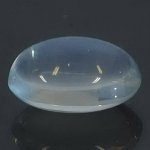We offer layaway, spread payments on the piece of your dreams. Ask us for details. Free insured shipping on all orders !!!

Antique jewelry glossary
Welcome to our extensive antique jewelry glossary with around 1,500 jewelry related entries.If you feel you are missing an explanation, feel free to let us know and we will add it.
A - B - C - D - E - F - G - H - I - J - K - L - M - N - O - P - Q - R - S - T - U - V - W - X - Y - Z all
Moonstone

See our: Moonstone jewelry.
Cabochon moonstones generally have a sheen known as adularescence, which is caused by including alternate layers of albite which spread the light falling on the dome. The color of the sheen is blueish on the finest stones, and whitish on more common stones.
A variety of orthoclase Feldspar that is transparant or translucent. When cut en cabochon, it has a sheen known as adularescence, due to including alternate layers of albite which spread the light falling oon the dome. The color of the sheen is blueish on the finest stones, and whitish on more common stones having thicker layers. The stones are almost always cut as cabochons, and sometimes show chatoyancey in the form of a translucent band that merges into a transparent band of adularia.
Moonstone has been imitated in glass and also by synthetic spinel that has been heated. "Black moonstone" is a misnomer for a dark variety of labradorite, and "pink moonstone" for a pink scapolite.
From: An Illustrated Dictionary of Jewelry, autor: Harold Newman, publishers: Thames and Hudson
Moonstone and superstitions and common beliefs
- birthstone or month stone for June
- protects travelers, especially from danger by sea
- cures consumption, dropsy, and kidney troubles
- allays fever
- reconciles lovers
- brings good fortune
- in divination it is placed in the mouth during a waning moon to help determine course of action.
"Healing properties" of Moonstone
Moonstone stimulates the functioning of the pineal gland and balances internal hormone cycles with nature's rhythms.
Moonstone is a stone of inner growth and strength.
Though often considered to be a woman's stone, it can be beneficial to men in opening the emotional self.
Moonstone and a more scientific approach
Moonstone is typically a potassium aluminium silicate, with the chemical formula KAlSi3O8.
The most common moonstone is of the mineral adularia. The plagioclase feldspar oligoclase also produces moonstone specimens. Its name is derived from a visual effect, or sheen, caused by light reflecting internally in the moonstone from layer inclusion of different feldspars.
Moonstone's delicate beauty and its long heritage make it perhaps the most familiar gem quality member of the feldspar group. Moonstone is composed of two feldspar species, orthoclase and albite. The two species are intermingled. Then, as the newly formed mineral cools, the intergrowth of orthoclase and albite separates into stacked, alternating layers. When light falls between these thin, flat layers, it scatters in many directions producing the phenomenon called adularescence.
Deposits of moonstone are found in many countries and places: the European Alps; Brazil; India; Mexico; Myanmar; Madagascar; Sri Lanka; the USA, specifically Pennsylvania and Virginia; and Tanzania. However, it is Sri Lanka that produces the highest quality moonstones.
From: Wikipedia









